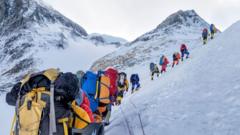The rise in climbing fees has been a topic of discussion for years, with many professionals questioning whether it will effectively reduce the number of permits issued. Nepal's tourism director, Narayan Prasad Regmi, emphasized the long-overdue need for a permit review, although he did not clarify how the increased revenue will be allocated.
British mountaineer Kenton Cool noted that while the fee increases are significant, they may not deter seasoned climbers, who often view these costs as a small part of their overall expenditure. He expressed hope that the additional funds will facilitate improved management of the mountain and its resources.
In light of mounting concerns about congestion and safety on Everest, which has seen up to 300 climbing permits issued annually, the Nepalese Supreme Court mandated in April 2024 that the government should impose limitations on future permits. This ruling underlines the need to respect the mountain’s natural capacity and avoid overcrowding.
Furthermore, the Nepalese army has actively engaged in initiatives to clean the mountain, aiming to tackle the significant waste accumulated over the years. Their efforts have so far resulted in the recovery of 119 tonnes of rubbish along with human remains, yet it is estimated that around 200 more bodies still remain on the mountain.
As Nepal remains home to eight of the world’s tallest peaks, the relationship between tourism, environmental preservation, and safety continues to be a critical discussion point for both local authorities and the global climbing community.
British mountaineer Kenton Cool noted that while the fee increases are significant, they may not deter seasoned climbers, who often view these costs as a small part of their overall expenditure. He expressed hope that the additional funds will facilitate improved management of the mountain and its resources.
In light of mounting concerns about congestion and safety on Everest, which has seen up to 300 climbing permits issued annually, the Nepalese Supreme Court mandated in April 2024 that the government should impose limitations on future permits. This ruling underlines the need to respect the mountain’s natural capacity and avoid overcrowding.
Furthermore, the Nepalese army has actively engaged in initiatives to clean the mountain, aiming to tackle the significant waste accumulated over the years. Their efforts have so far resulted in the recovery of 119 tonnes of rubbish along with human remains, yet it is estimated that around 200 more bodies still remain on the mountain.
As Nepal remains home to eight of the world’s tallest peaks, the relationship between tourism, environmental preservation, and safety continues to be a critical discussion point for both local authorities and the global climbing community.

















